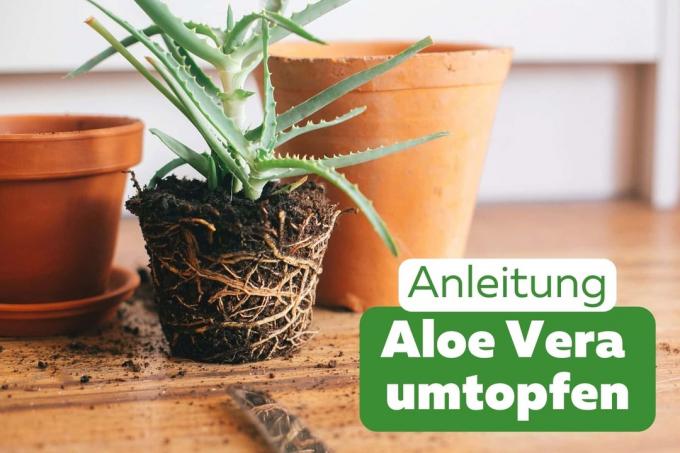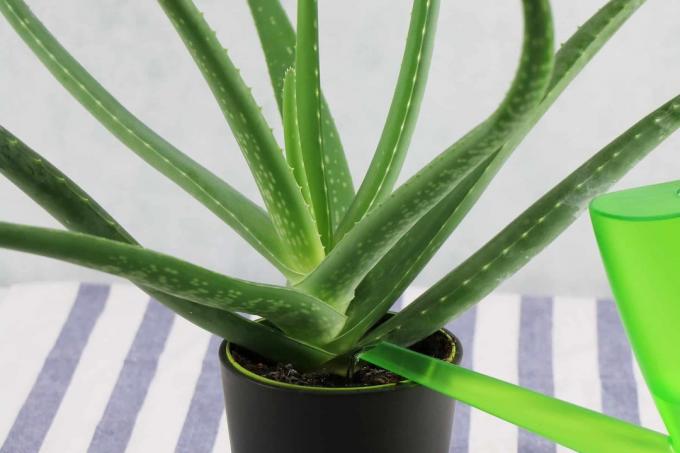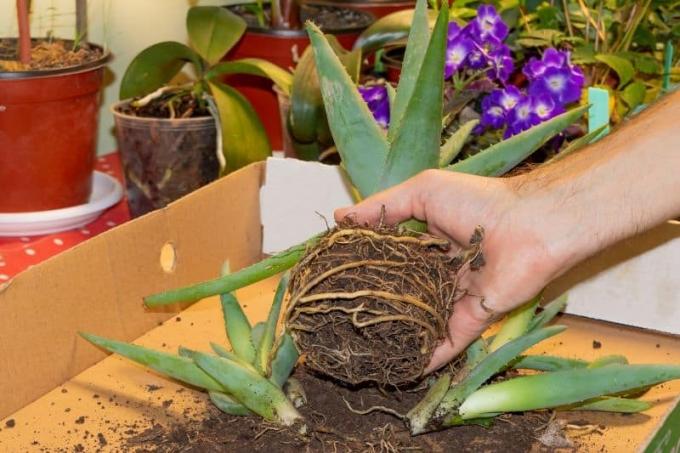
Potted plants need to be repotted regularly. A container becomes too small over time, the soil loses a lot of nutrients despite fertilization. In the following post, we will show you how to use the popular aloe vera Repot the plant properly.
In a nutshell
- Repot aloe vera every two to three years
- Cactus soil ideal substrate for succulents
- alternatively, mix nutrient-poor herbal soil with sand
- Spring is the best time for repotting
- do not water for a long time before repotting
Table of Contents
- Repot aloe vera
- 1. stop watering
- 2. watch the time
- 3. Prepare pot
- 4. Use ideal soil
- 5. Repot aloe vera
- 6. Plant aloe vera
- 7. Choose the right location
- frequently asked Questions
Repot aloe vera
How to repot the aloe vera plant step by step:
1. stop watering
Anyone who has decided to repot their aloe vera must prepare the plant for this. Therefore, the first step is important weeks in advance. You should see the plant no more watering. In this way, the soil dries well and can later be better detached from the root ball.

A notice: Don't worry because the aloe is a succulent acts, which stores moisture in the fleshy leaves, the plant does not mind a longer dry period.
2. watch the time
Ideally, aloe vera is repotted in spring after the hibernation. Because at this time the plants can root best, as they are due to the rising Sun also become more active. In principle, however, you can repot your aloe vera at any other time - provided that this is outside the flowering period.
3. Prepare pot
To do this, select a new, larger container. On the ground above the drain hole, it is advisable to lay a drainage layer:
- Distribute potsherds or balls on the bottom of the pot
- Plant fleece superior
So no soil can clog the hole for draining excess irrigation water.
Tip: waterlogging should be avoided with the rather drought-loving aloe. You should therefore drain the drip tray about half an hour after each watering.
4. Use ideal soil
Fill the bucket halfway with soil. Cactus soil or alternatively low-nutrient herbal soil from the trade are suitable for this, which you mix with a part of sand. The substrate should be sparse, very loose and permeable.
5. Repot aloe vera
Carefully remove the aloe vera from the old pot. Under no circumstances should you exert pressure on the fleshy leaves, as these are very sensitive to pressure and can easily be injured or even broken off when you touch them. Carefully remove all of the old, dry soil from the root ball.

Tip: It is best to tap the root ball very carefully on the tabletop.
6. Plant aloe vera
Place the aloe in a new container, carefully filling in the remaining soil.
Tip: You should not water your aloe for the first week after repotting. After that, as usual, only moderately. Under no circumstances should you water the plant well, as is usual with other plants after repotting.
7. Choose the right location
Choose a bright location without direct sunlight for the first few days. Because repotting always means stress for the plant. In a sunny location, the aloe can recover for the first few days.
frequently asked Questions
It is sufficient if you repot the aloe vera every two to three years. However, if you notice that a pot is getting too small or the soil has become too compacted, then it is advisable to repot the plant earlier.
If you repot your plant regularly, you can do without fertilizing completely and only add a little water every few weeks. Because succulents require little care and store the moisture and nutrients in their leaves.
When you choose a new pot, you should not only pay attention to the size, so that the root ball can expand again. The material is also important here. Unglazed clay or ceramic vessels are ideal. In this way, moisture can escape through the walls and waterlogging can also be avoided. Plastic buckets do not offer this.
If you still have used pots available or you repot the aloe although the pot has not yet become too small, you can also use these. Cleaning is important. Ideally, you should use hot vinegar water and a brush to rub the inside walls well.
The plant genus of aloe vera includes about 450 species. All species are also succulents, so there are no differences in transplanting, timing, or preferred substrate. As a rule, the "true aloe" is cultivated in the local latitudes.
